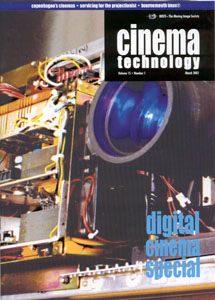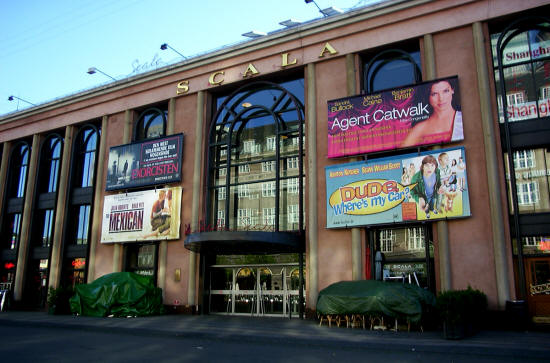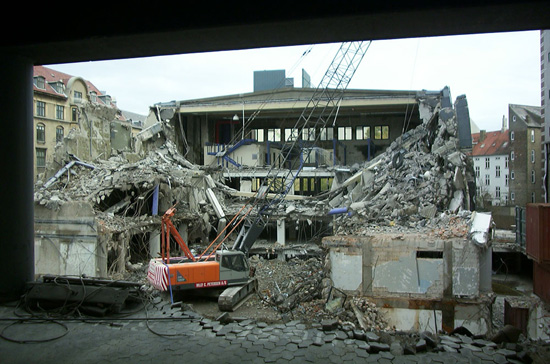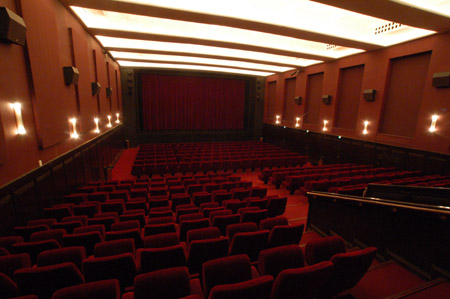New face of Copenhagen’s Cinemas |
Read more at in70mm.com The 70mm Newsletter |
| Written and photographed by: Thomas Hauerslev. This article was first published in Cinema Technology, March 2002. Reprinted with permission from Jim Slater. | Date November 30, 2003 |
 This article from Cinema Technology, March 2002, updates the first article about the cinemas of
Copenhagen appeared in Cinema Technology in March 2001. It’s time for a
little update due to the dramatic changes, which have happened, in the last
year, reflecting changes in distribution and attendance performance, some of
which will also apply in other cities as well.
This article from Cinema Technology, March 2002, updates the first article about the cinemas of
Copenhagen appeared in Cinema Technology in March 2001. It’s time for a
little update due to the dramatic changes, which have happened, in the last
year, reflecting changes in distribution and attendance performance, some of
which will also apply in other cities as well.2001 proved to be a very tough year for the German CinemaxX group in Denmark. In late 2000 CinemaxX had very aggressive plans for Denmark with projects in Copenhagen, Odense (Closed), Århus (planned 2003 opening) and Aalborg. At this point, only Copenhagen is up and running and in Århus, the rumour goes, they will do what they can to get out of the engagement. With a record loss of 19.1 million Danish kroner (2,3 million USD) for the first 4 months (of 2001), all CinemaxX’s remaining Danish cinemas are now for sale. In September 2000 their first 7-screen cinema opened in Odense. It was less than a kilometre from the 9-screen BioCity managed by Nordisk Film. The cinema in Odense proved to be a financial disaster, and the 7 screens had to close again by the end of July 2001, less than a year after the opening. The shopping centre was always empty except for the cinema and now it is rumoured that IKEA will take over the building. A month after the Odense opening, the 3118-seats/10-screen complex opened at Fisketorvet, slightly outside Copenhagen city centre. There are speculations that possibly Nordisk Film or Sandrew/Metronome, the main competitors, will take over their screens (Source Politiken: July, 26, 2001). It’s highly unlikely, however, as the rent is far too high (It’s a public secret that CinemaxX’s annual rent at Fisketorvet is in the neighbourhood to 20 million Danish kroner, but please keep this to your self). In the event someone would buy the cinemas, the contract should be re-negotiated, if the cinemas are ever to make a profit. |
More in 70mm reading: 70mm Cinemas and Film in Denmark Cinemas of Copenhagen - An in depth look at all the screens PDF: New face of Copenhagen’s Cinemas Internet link: |
Closure of the Scala |
|
 Scala
cinemas. Scala
cinemas.Another sad story from central Copenhagen was the closure of the excellent 7-screen Scala cinemas in central Copenhagen. In April 2001 it was announced that Scala would close by the end of June 30, 2001. Scala opened March 9, 1989 and thus stayed open only 12 years. The reason for the closure was not the intensified competition from CinemaxX and Nordisk Film, as one would expect. Scala was located on the top floor of a shopping mall that never became the expected success. The new owners had plans to turn the building into a hotel or office space and Sandrew/Metronome, the operators of the cinema, decided that a cinema on the third floor would not be profitable, if all other levels were turned into office space or a hotel. So they decided to close it. Today, 7 months after the theatre´s closure, the Scala shopping centre is still open with many shops and restaurants. Posters from Scala’s last programme are still displayed on the boarded-up top floor of the mall, like a ghost cinema. The remaining tenants all have long-tem contracts and are reluctant to leave. Rumour has it that there are many legal disputes with the new owners. On the positive side, the new 4-screen “Empire Bio” (629 seats) just outside city centre in Nørrebro is a complete success. The Empire Bio (opened January 3, 2001) generated total audience patronage of some 135.000 in only 7 months! The style is that of a local cinema with high-tech screens, set to the industry’s highest standards for sound and image. To begin with there was a no-commercial/adverts policy, but I believe they have abandoned that now. Unlike the cinemas in the city centre, the show times are different. Usually films in the city are shown at 12, 14:20, 16:40, 19 and 21:30. Empire Bio show times are typically 12:30, 15, 17:30, 20:00 and 22:30. The evening performances are very popular and you will often find performances to be sold-out. Empire Bio has already developed a certain cult status among the locals. Apparently a total success. And I must admit it is a nice place to go to. There are no flashing lights, no bright and noisy foyer. It’s all kept very quiet with a good bar, nice people and excellent screens. |
|
Demolition of Cinerama history |
|
 Kinopalæet
is demolished 2001 Kinopalæet
is demolished 2001For the historically-minded reader, the last trace of Cinerama became the victim of the wrecking ball last November. Former “Kinopalæet” (“Cinema Palace”) was demolished to make room for new office space. Kinopalæet closed in 1981 and survived for 20 years as office space. The name Kinopalæet was always associated with big premieres and cutting edge technology (WideScreen, 3D, CinemaScope, 70mm and Cinerama). A few days before demolition began I sat up a meeting with former Cinerama projectionist, Mr. Ole S. Olsen inside the auditorium. We talked for 30 minutes about the old days and took a few pictures in front of the former “Able” projection room. The demolishing took slightly more than a month and I managed to take a few pictures of the final days of Kinopalæet. Please read the whole story about Kinopalæet in a future issue of Cinema Technology. It’s not a total disappearance, however, as the name Kinopalæet lives on atop Sandrew/Metronome’s new (opened August 7, 2001) 7-plex cinema in the Copenhagen suburb of Lyngby. The new Kinopalæet’s 7 screens are built to meet the industry’s finest standards but is also experiencing very slow business, especially in the evenings. |
|
Cinemas after Dark |
|
|
Generally speaking, Danish cinemas placed in malls/shopping centers do not
work well because nobody wants to see films there after the normal closing
time of the surrounding shops. One of the first, BioCity (Previously know as
Bio Trio), in the suburb called Taastrup, has always struggled to get an
audience for the 21:00 performances. The 19:00 performances have been fair,
but with when the area shops closing at 17:30, many do not dare to go into a
shopping centre. It’s big, empty, cold and basically un-friendly to human
beings. CinemaxX’s Fisketorvet 10-screen is particularly unpleasant if you
approach it by foot or bike as it is surrounded by the harbour, a freeway
and the railway-shunting yard. Copenhagen is generally a very safe to live
in and I don’t think there are any records of people being mugged on their
way to CinemaxX’s Fisketorvet, but it’s simply not a nice place to go to
when it’s dark. |
|
What's Left to See? |
|
 Beautiful
Grand Theatre, screen 3 Beautiful
Grand Theatre, screen 3What’s left for the enthusiast to go to in Copenhagen? Well speaking personally; I prefer the Imperial Bio with it’s 40 year history of being a 70mm house with state-of-the-art technology etc. In recent years it has become maybe too “flashy” or bright in the foyer for my taste, but still, the best place to see a film. Films presented there have become far too mainstream, however. “Harry Potter” and “Lord of the Rings” are obvious films to show here, but it would have been nice to experience Panavision films like “Amélie” or “Malena” on the big screen with big sound – that didn’t happen. Second in line in the viewing preference is probably the Grand screen #3. Not particularly because of size or techno-foolishness, but because of the atmosphere of the Grand. The front is nicely decorated with 3-sheet posters, the foyer is pleasant (but small), beer is well served and I generally like the idea of movie magazines, posters and reviews on the pin boards. The whole place “has the smell of cinema” and a touch of Danish “hygge” without being out of fashion or too art-cinema like. The difference is probably because the Grand is independent. Finally, the Dagmar #1, also a nice place to be, but a bit more streamlined compared to the Grand, (no) thanks to the Swedish owners. Being part of a big conglomerate of cinema and media (Owned by Sandrew/Metronome), there are certain standards to follow about interior design; the foyer is too bright and “stream lined” for me. On the very positive side, the snacks are good and there are posters and, always, reviews to read. The crew are always nice and competent and I love the big red neon light on the marquee and the original teak woodwork inside the cinema. Well, judge for yourself next time around. The listed favourites are fine places to spend a couple of hours enjoying a film during your next visit to “Wonderful, wonderful Copenhagen”. |
|
|
Go: back
- top - back issues Updated 22-01-25 |
|
